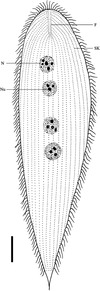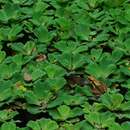Description
(
anglais
)
fourni par AmphibiaWeb articles
Body is large. Males are 63-68 mm SVL and females are 75-76 mm SVL. Head is relatively flat/depressed. The snout protrudes past the chin in profile, has a conspicuous canthus rostralis, and tapers into a rounded point. The loreal region slants outwards. External nares are near the end of the snout. Vomerine teeth are longitudinally arranged. The tongue is large, and its posterior end has a large notch. Behind the corners of the mouth are conspicuous maxillary glands. Skin is smooth except for the posterior end of the dorsum, which is granular. Dorsolateral folds are flat and straight but prominent, running from behind the eye to past the hip area. Limbs are robust. The finger and toe tips are rounded, but not expanded. Finger tips lack lateral grooves or have indistinct lateral grooves. Hind limbs are long, up to 1.5 times SVL. The tibiotarsal joint reaches up to between the eye and snout area when adpressed, and tibiotarsal joints are overlapping when adpressed. Length of foot (phalanges plus metatarsals) equals length of tibiofibula, about half the SVL. Ends of the toes have horseshoe-shaped horizontal grooves. Subarticular tubercles and metacarpal tubercles are well developed and supernumerary tubercles are present below the bases of fingers. There is 3/4 webbing between the toes (Yang and Rao 2008). Relative lengths of fingers are 3, 1, 4, 2, with the first and third fingers being the longest (Ye et al. 1993).The male has a single pair of external subgular vocal sacs, as well as rounded humeral glands located anteriorly above the base of the front limbs, and inconspicuous nuptial pads on the thumbs. Males have linea masculina, a recently described secondary sex characteristic consisting of longitudinal connective tissue bands bordering specific abdominal muscles (see Liu 2005).The dorsum is brown or brown-yellow. The belly is white. Along the dorsolateral folds are longitudinal black marks. Lateral surfaces have black spots. Dorsal surfaces of the hind limbs have black horizontal stripes and posterior sides of the legs have gray-black spots. Marks on the dorsal surfaces of the legs are arranged longitudinally in a row (Yang and Rao 2008).At Gosner stage 27, the tadpole body is depressed. Eyes are dorsolateral. Tail fins are moderately high. Dorsal and lateral sides are grayish green with dark speckles. Tail is brown with larger speckles and pointed at the tip. The upper jaw sheath is narrow. Marginal papillae are cone-shaped. One submarginal row of papillae is present. All papillae are unpigmented (Gawor et al. 2009).In life the tadpole is silver-whitish, with a short dark stripe running from the nares to the anterior corner of the eye and a dark fleck posterior to the eye. distinguishing it from the greenish-brown to grayish color of R. attigua, R. maosonensis, and R. nigrovittata (Gawor et al. 2009).
- Gawor, A., Hendrix, R., Vences, M., Böhme, W., and Ziegler, T. (2009). ''Larval morphology in four species of Hylarana from Vietnam and Thailand with comments on the taxonomy of H. nigrovittatus.'' Zootaxa, 2051, 1-25.
- Kuangyang, L., Wenhao, C., Baorong, G., Huiqing, G., Haitao, S., van Dijk, P. P., and Truong, N. Q. (2004). Hylarana guentheri. In: IUCN 2008. 2008 IUCN Red List of Threatened Species. . Downloaded on 04 May 2009.
- Liu, C. C. (1935). '''The Linea masculina,' a new secondary sex character in Salientia.'' Journal of Morphology, 57(1), 131-145.
- Lv, S., Zhang, Y., Steinmann, P., and Zhou, X.-N. (2008). ''Emerging angiostrongyliasis in mainland China.'' Emerging Infectious Diseases, 145, 161-164.
- Zhou, J., Bjourson, A. J., Coulter, D. J. M., Chen, T., Shaw, C., O'Rourke, M., Hirst, D. G., Zhang, Y., Rao, P., and McClean, S. (2007). ''Bradykinin-related peptides, including a novel structural variant, (Val1)-bradykinin, from the skin secretion of Guenther's frog, Hylarana guentheri and their molecular precursors.'' Peptides, 28, 781-789.
- Zhou, J., McClean, S., Thompson, A., Zhang, Y., Shaw, C., Rao, P., and Bjourson, A. J. (2006). ''Purification and characterization of novel antimicrobial peptides from the skin secretion of Hylarana guentheri.'' Peptides, 27, 3077-3084.
- auteur
- Anna Chow
- auteur
- Michael Li
Distribution and Habitat
(
anglais
)
fourni par AmphibiaWeb articles
This species has a fairly wide distribution in southern China, Hong Kong, Macau, Taiwan, and Viet Nam (Kuangyang et al. 2004), and has also been recently introduced to Guam (Christy et al. 2007). It is a lowland species and occurs at elevations up to 1100 m above sea level (Kuangyang et al. 2004). It lives in pools, marshes, ditches, and paddy fields, and hides in tunnels and under freshwater vegetation (Kuangyang et al. 2004).
- auteur
- Anna Chow
- auteur
- Michael Li
Life History, Abundance, Activity, and Special Behaviors
(
anglais
)
fourni par AmphibiaWeb articles
Mating season occurs from May to June. During breeding season males emit a low pitched croak. Breeding occurs in ponds, rice fields, and slow-moving streams. Females produce eggs once a year, with each clutch consisting of 2000-3000 eggs. Metamorphosis lasts from 45-60 days (Kuangyang et al. 2004).Defensive skin secretions include multiple bradykinin-related peptides including a novel bradykinin structural variant, (Val1)-bradykinin (Zhou et al. 2007). Several novel anti-microbial peptides have also been reported for this species, including guentherin, brevinin-2GHa, brevinin-2GHb, brevinin-2GHc, temporin-GH (Zhou et al. 2006). The brevininin-2 peptide family is specific to Eurasian ranids (Zhou et al. 2006). Each R. guentheri antimicrobial peptide by itself exhibited significant antimicrobial activity against both Gram-positive and Gram-negative reference bacteria; these AMPs have not yet been tested in combination, which can result in a 10 to 100-fold increase in antimicrobial activity (Zhou et al. 2006). This species, along with other Chinese anurans (Rana limnocharis, R. plancyi and Bufo melanostictus), has been found to be one of many paratenic (intermediate) hosts for the parasite Angiostrongylus cantonensis, which causes the disease angiostrongyliasis in humans (Lv et al. 2008).
- auteur
- Anna Chow
- auteur
- Michael Li
Life History, Abundance, Activity, and Special Behaviors
(
anglais
)
fourni par AmphibiaWeb articles
Can tolerate disturbed habitat (Kuangyang et al. 2004). It appears to be common in Viet Nam but is declining in China due to habitat loss and overcollection for human consumption (Kuangyang et al. 2004). However, it has also been reported to be a dominant species even when other amphibians are declining (Zhou et al. 2006). It is expanding in Guam, where it has been introduced (Christy et al. 2007).
- auteur
- Anna Chow
- auteur
- Michael Li
Sylvirana guentheri: Brief Summary
(
anglais
)
fourni par wikipedia EN
Hylarana guentheri (Günther's frog) is a species of frog in the family Ranidae. It was formerly placed in the genus Rana. It is found in China, Hong Kong, Macau, Taiwan, Vietnam, and possibly Cambodia and Laos. An introduced population is found on Guam. An alternate common name is Günther's Amoy frog, and the honorific is often spelled "Guenther's".
Its natural habitats are subtropical or tropical moist lowland forest, subtropical or tropical moist shrubland, subtropical or tropical dry lowland grassland, rivers, intermittent rivers, swamps, freshwater marshes, intermittent freshwater marshes, arable land, plantations, rural gardens, water storage areas, ponds, aquaculture ponds, irrigated land, seasonally flooded agricultural land, and canals and ditches. It is not considered a threatened species by the IUCN.

Protoopalina pingi, a parasite of the rectum of Hylarana guentheri in China
Günther's frog is a medium to large-sized frog that may grow up to 10 cm (3.9 in) in snout-vent length.
Parasites of this frog include the opalinid Protoopalina pingi, in the rectum.
- licence
- cc-by-sa-3.0
- droit d’auteur
- Wikipedia authors and editors
Sylvirana guentheri: Brief Summary
(
espagnol ; castillan
)
fourni par wikipedia ES
Sylvirana guentheri es una especie de anfibio anuro de la familia Ranidae.
- licence
- cc-by-sa-3.0
- droit d’auteur
- Autores y editores de Wikipedia
Hylarana guentheri
(
basque
)
fourni par wikipedia EU
(RLQ=window.RLQ||[]).push(function(){mw.log.warn("Gadget "ErrefAurrebista" was not loaded. Please migrate it to use ResourceLoader. See u003Chttps://eu.wikipedia.org/wiki/Berezi:Gadgetaku003E.");});
- licence
- cc-by-sa-3.0
- droit d’auteur
- Wikipediako egileak eta editoreak
Hylarana guentheri: Brief Summary
(
basque
)
fourni par wikipedia EU
Hylarana guentheri Hylarana generoko animalia da. Anfibioen barruko Ranidae familian sailkatuta dago, Anura ordenan.
- licence
- cc-by-sa-3.0
- droit d’auteur
- Wikipediako egileak eta editoreak
Sylvirana guentheri: Brief Summary
fourni par wikipedia FR
Sylvirana guentheri est une espèce d'amphibiens de la famille des Ranidae.
- licence
- cc-by-sa-3.0
- droit d’auteur
- Auteurs et éditeurs de Wikipedia
Sylvirana guentheri: Brief Summary
(
portugais
)
fourni par wikipedia PT
Sylvirana guentheri é uma espécie de anfíbio anuro da família Ranidae. Está presente em China, Guam, Hong Kong, Macau, Taiwan, Vietnam. Foi introduzida em Guam.
- licence
- cc-by-sa-3.0
- droit d’auteur
- Autores e editores de Wikipedia


![]() Media related to Hylarana guentheri at Wikimedia Commons
Media related to Hylarana guentheri at Wikimedia Commons  Protoopalina pingi, a parasite of the rectum of Hylarana guentheri in China
Protoopalina pingi, a parasite of the rectum of Hylarana guentheri in China